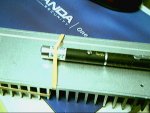thermal sensors are the way to go, definitely. except for really low powered lasers, under 10mw perhaps. but who would want such lasers, and want to measure those anyway? ;-)
(yellow and blue lasers come to mind, though)
someone likes to do a feeler in groupbuys for tiny TECs? they must be relatively cheap in larger numbers. if interest is high enough..?
if we get nice ones, it could open the way for a whole new class of diy "pointers". with one (or more) TECs inside, temperaturestabilized, or cooled down for even lower wavelength (635nm!). no more dutycycle, no more kinks, powerfluctuations and the like! thats what my next laserproject will be.
manuel
While they would be great for LPMs, I wrote a rather lengthy post as to why they are not as useful as it first seems for pointers, I will try and find it and post it up.
EDIT, found it:
"That was one of the inherent flaws of the Spyder II laser (dunno about spyder III). The peltier would keep the crystals (or diode, dunno what they decided to cool...probably both) cool for a bit of time, but the problem is the sinking.
After a limited amount of time the laser itself would overheat (remember reading long ago some user mention the laser getting HOT quick), due to a lack of thermal mass. The heat itself cannot be radiated fast enough.
When the hot plate of the TEC becomes to hot, the effectiveness of the peltier drops significant, with the "microcontroller" not being able to hold a temperature due to an inherent lack of sinking mass, the stability goes out the window. (Hercules uses active cooling, allowing complete thermal stability over time)
Though these 8X 5,6mm diodes do radiate less heat than a DPSS laser, their need for temperature stability is nowhere near that of a tuned DPSS system.
Another thing to consider is that a peltier is 5-10% efficient and will result in extra heat being dumped into the host (it is not a magical device that teleports heat to a distant black hole), effectively shortening the "duty cycle", very counter-productive.
In our case, limited thermal mass and passive cooling, adding a peltier which would admittedly add a "cool" factor to a host, is not justifiable from an engineering point of view, imo."







